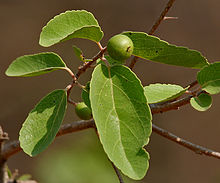Flacourtia указывает
| Flacourtia указывает | |
|---|---|

| |
| Научная классификация | |
| Королевство: | Plantae |
| Клада : | Трахеофиты |
| Клада : | Покрытосеменные |
| Clade: | Eudicots |
| Clade: | Rosids |
| Order: | Malpighiales |
| Family: | Salicaceae |
| Genus: | Flacourtia |
| Species: | F. indica
|
| Binomial name | |
| Flacourtia indica | |
| Synonyms[2] | |
|
List | |
Flacourtia indica (обычно известный как Рамончи , слива губернатора и индийская слива ), является видом цветущего растения, родом из большей части Африки и тропических и умеренных частей Азии. Он имеет различные применения, в том числе народное лекарство, топливо, корм животных и пищу человека.
Описание
[ редактировать ]Это густой кустарник или дерево с колючим стволом и ветвями. В виде кустарника он растет до 25 футов (7,6 м), и в качестве дерева он достигает максимальной высоты около 50 футов (15 м). Опубликованные ветви несут овальные листья. Семена рассеяны птицами. [ 3 ] Это дерево имеет шипы, похожие на дерево лайма или лимона. Если в контакте с шипами, это оставляет неприятную жгучую боль. [ Цитация необходима ]
Таксономия
[ редактировать ]Он также широко известен как слива «Батако». [ 4 ] [ 5 ]
It was first described and published as Gmelina indica by Nicolaas Laurens Burman in Fl. Ind. 132, t. 39, fig. 5 in 1768, it was then re-published as Flacourtia indica by Elmer Drew Merrill in Interpr. Herb. Amboin. on page 377 in 1917.[2][6]
F. indica and Flacourtia ramontchi (the Madagascar plum) are treated as separate species, including by Plants of the World Online,[7][8][9] but not by GRIN (United States Department of Agriculture and the Agricultural Research Service).[10]
Distribution
[edit]It is native to the countries (and regions) of Aldabra (Seychelles), Assam, Bangladesh, Botswana, Burundi, Cambodia, southeastern China, Comoros, Congo, Ethiopia, Hainan, India, Java, Kenya, Laccadive Islands, Laos, Lesser Sunda Islands, Madagascar, Malawi, Malaya, Mozambique, Myanmar, Namibia, Nepal, Pakistan, Philippines, Rwanda, Somalia, Sri Lanka, South Africa (in the Cape Provinces, KwaZulu-Natal and Northern Provinces), Sudan, Sulawesi, Tanzania, Thailand, Uganda, Vietnam, Zambia, Zaire and Zimbabwe.[2]
It has been introduced into various places such as Angola, Bahamas, Chad, Dominican Republic, Hawaii, Jamaica, Leeward Islands, Mauritius, Nicobar Islands, Puerto Rico, (Island of) Réunion, Society Islands, Trinidad and Tobago.[2]
Uses
[edit]The ramontchi fruit itself is about an inch thick and red ripening purple. It is very fleshy and has 6 to 10 seeds in layered carpels. The pulp is yellow or white and sweet with an acidic tang. It is eaten raw or made into jelly or jam. It can be fermented to make wine.[11]
The leaves and roots are used in herbal medicine for treatment of snakebite. The bark is believed to be effective for arthritis. Most parts of the plant are used for cough, pneumonia, and bacterial throat infection. It has also been used for diarrhoea.
In India, it is used in folk medicine to treat functional disorders like rheumatoid arthritis and gout. Its berries are edible, and the bark can be triturated (ground) with sesamum oil and then used as alignment of rheumatism. Similarly, the extract of its fruit has diuretic, hepatoprotective, and antidiabetic properties (Patro et al. 2013).[12] As it contains a glucoside ('Flacourside'),[13] and 'Flacourtin' (an ester).[14]
Antimalarial compounds have been found in the aerial parts of Flacourtia indica.[15]
The tree is planted as a living fence; it was one of the species used for the Indian Inland Customs Line. The wood is used for firewood and small wooden tools such as plough handles.[11]
Cultivation
[edit]The plant is known as an occasionally invasive introduced species in some areas. It has been cultivated in Florida in the United States, and today, it occurs as a weed in some parts of the state.[16]
References
[edit]- ^ Botanic Gardens Conservation International (BGCI) & IUCN SSC Global Tree Specialist Group (2019). "Flacourtia indica". IUCN Red List of Threatened Species. 2019: e.T146188176A146223268. doi:10.2305/IUCN.UK.2019-2.RLTS.T146188176A146223268.en. Retrieved 6 November 2022.
- ^ Jump up to: a b c d "Flacourtia indica (Burm.f.) Merr. | Plants of the World Online | Kew Science". Plants of the World Online. Retrieved 26 October 2023.
- ^ Pacific Island Ecosystems at Risk
- ^ "Flacourtia indica | batako plum /RHS Gardening". www.rhs.org.uk. Retrieved 27 October 2023.
- ^ Ndhlala, A.R.; Chitindingu, K.; Mupure, C.; Murenje, T.; Ndhlala, F.; Benhura, M.A.; Muchuweti, M. (2008). "Antioxidant properties of methanolic extracts from Diospyros mespiliformis (jackal berry), Flacourtia indica (Batoka plum), Uapaca kirkiana (wild loquat) and Ziziphus mauritiana (yellow berry) fruits". Int. J. Food Sci. Technol. 43 (2): 284–288. doi:10.1111/j.1365-2621.2006.01431.x.
- ^ "Flacourtia indica | International Plant Names Index". www.ipni.org. Retrieved 27 October 2023.
- ^ "Flacourtia ramontchi L'Hér. | Plants of the World Online | Kew Science". Plants of the World Online. Retrieved 26 October 2023.
- ^ "Flacourtia ramontchi | ramontchi /RHS Gardening". www.rhs.org.uk. Retrieved 26 October 2023.
- ^ "Flacourtia ramontchi L'Herit. | Species". India Biodiversity Portal. Retrieved 26 October 2023.
- ^ "Flacourtia indica (Burm. f.) Merr". Germplasm Resources Information Network. Agricultural Research Service, United States Department of Agriculture. Retrieved 27 July 2016.
- ^ Jump up to: a b World Agroforestry
- ^ Patro, S.K.; Behera, P.C.; Kumar, P.M.; Sasmal, D.; Padhy, R.K.; Dash, S.K. (2013). "Pharmacological review of Flacourtia sepiaria (Ruxb.)". Scholars Academic Journal of Pharmacy. 2 (2): 89–93.
- ^ Amarasinghe, N.R.; Jayasinghe, L.; Hara, N.; Fujimoto, Y. (2007). "Flacourside, a new 4-oxo-2-cyclopentenylmethyl glucoside from the fruit juice of Flacourtia indica". Food Chem. 102 (1): 95–97. doi:10.1016/j.foodchem.2006.05.004.
- ^ Bhaumik, P.K.; Guha, K.P.; Biswas, G.K.; Mukherjee, B. (1987). "Flacourtin, a phenolic glucoside ester from Flacourtia indica". Phytochemistry. 26 (11): 3090–3091. doi:10.1016/S0031-9422(00)84606-3.
- ^ Kaou, A.M.; Mahiou-Leddet, V.; Canlet, C.; Debrauwer, L.; Hutter, S.; Laget, M.; Faure, R.; Azas, N.; Ollivier, E. (2010). "Antimalarial compounds from the aerial parts of Flacourtia indica (Flacourtiaceae)". J. Ethnopharmacol. 130 (2): 272–274. doi:10.1016/j.jep.2010.04.045. PMID 20457242.
- ^ "Flacourtia indica in Flora of North America @ efloras.org". www.efloras.org. Retrieved 2017-08-01.
